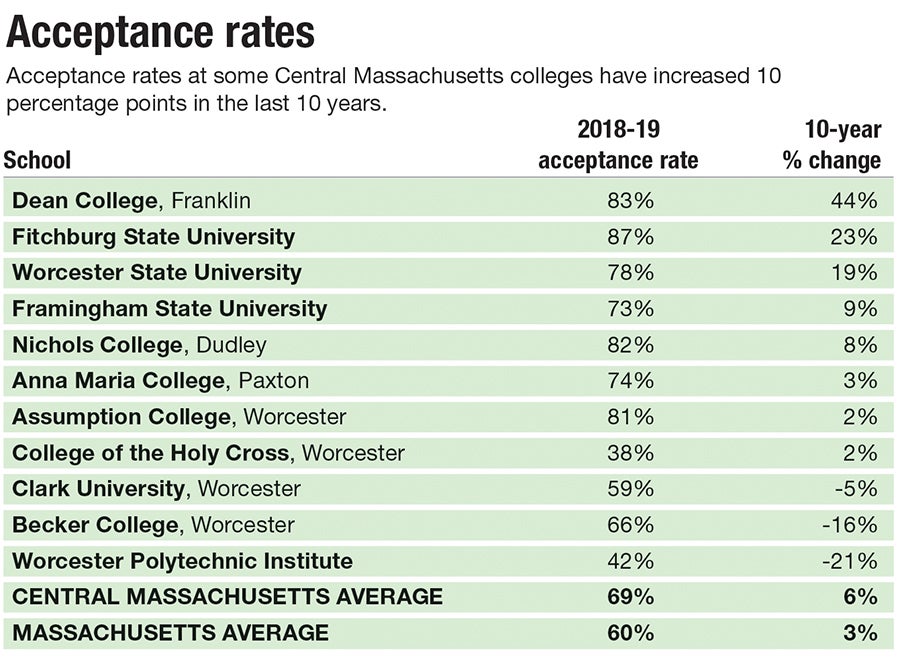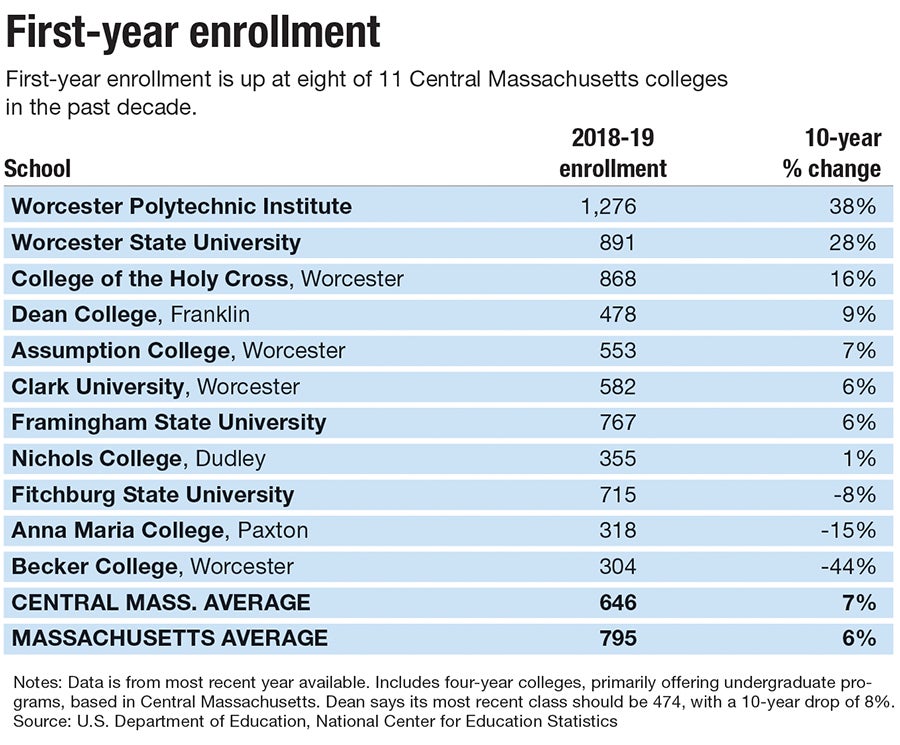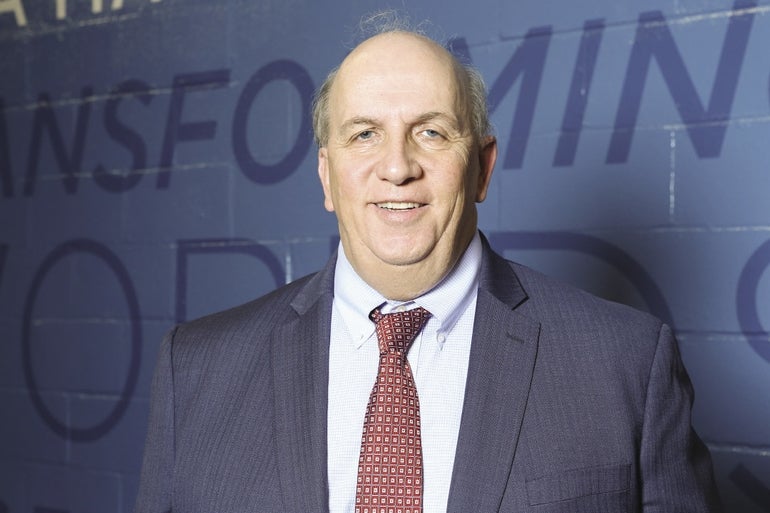An industry-wide spike in the number of applications from high school students has complicated the fine-tuned formula for figuring out which students – and how many – will ultimately enroll.
Get Instant Access to This Article
Subscribe to Worcester Business Journal and get immediate access to all of our subscriber-only content and much more.
- Critical Central Massachusetts business news updated daily.
- Immediate access to all subscriber-only content on our website.
- Bi-weekly print or digital editions of our award-winning publication.
- Special bonus issues like the WBJ Book of Lists.
- Exclusive ticket prize draws for our in-person events.
Click here to purchase a paywall bypass link for this article.
College admissions often thinks of itself as the cliched mix of art and science: Part marketing and data analytics, but still a lot of old-school relationship building.
In recent years though, an industry-wide spike in the number of applications from high school students has complicated the fine-tuned formula for figuring out which students – and how many – will ultimately enroll.
The application surge has sent acceptance rates and yield rates, which measures how many enroll, haywire in the last decade, according to a Worcester Business Journal review of federal admissions data for four-year colleges based in Central Massachusetts.
“No one ever has seen a crystal ball in how enrollment is going to shake out in a given year,” said Bob Mirabile, the vice president for enrollment management at Worcester’s Assumption College.

Students applying to more schools today can mask a looming crisis for higher education: a declining high school-age population. Colleges are already fighting for a shrinking pool of candidates, especially the colleges whose footprint doesn’t normally extend far beyond Central Massachusetts.
High school graduates peaked in Massachusetts in 2013, according to the Western Interstate Commission for Higher Education, which projects a 12% drop in the following two decades from that time. High school graduates across the Northeast peaked in 2010, according to the Colorado-based group.
That helps explain why Central Massachusetts colleges are looking broader geographically.
Worcester Polytechnic Institute, for example, is drawing more from faster-growing areas of the country, like California and Texas, as well as from Asia and Europe. The school has three full-time international recruiters.
Fitchburg State University, which has traditionally drawn overwhelmingly from Central Massachusetts, began recruiting last year in New York and New Jersey, adding to a candidate pool already expanded recently to Connecticut and Rhode Island.
With Fitchburg State’s core candidates looking at more places, said Jinawa McNeil, the school’s admissions director, Fitchburg State has as well.

Adjusting to technology and a swarm of applications
At Central Massachusetts colleges, applications are up 45% in the past decade, while the number of students enrolled is up 7%, according to the U.S. Department of Education.
That has forced college enrollment officials in Central Massachusetts and beyond to tweak the long-held and critical calculus for how many students they should admit and how many would ultimately enroll.
“They’re just less reliable now,” said Andy Palumbo, WPI’s associate vice president of enrollment management and the dean of admissions and financial aid.
One harsh reality of admissions is most students who are accepted will choose to go elsewhere. With so many more applications for a relatively flat enrollment, the yield – the number of accepted students who ultimately enroll – is down nearly everywhere.
But the rise in applications can be a boon to colleges: The number of applications can be key for marketing, and the acceptance rate is factored into rankings.
Scott Latham, a business professor at UMass Lowell who studies higher education, said a scramble to admit enough students with shrinking high school demographics has led to schools often accepting students they may not have otherwise, or grown their student body in an attempt to bring in ever-higher revenues.
“That means there’s some financial strain in the institution,” Latham said. “A rising acceptance rate is not a good thing.”

Latham doesn’t see such challenges improving any time soon, either. After all, he said, today’s declining high school graduates are tomorrow’s declining graduate student population.
“I don’t have a lot of faith that higher education is going to endure as it stands today,” he said.
Admissions offices are also working to better appeal to tech-savvy high schoolers, who are more likely to want to explore their potential college on platforms like Twitter or YouTube. Admissions officers said they’ve emphasized email and text communications with students and targeted advertising.
“Our toolbox tends to get bigger and bigger,” said Ann McDermott, the admissions director at the College of the Holy Cross.
Still, colleges aren’t giving up on more traditional tactics, like attending high school fairs, holding interviews, sending mailers or encouraging campus visits.
“I’ve been in this profession now for 20 years,” said Shayna Eddy, Framingham State University’s director of undergraduate admissions. “As much as things have changed, things have definitely remained the same.”
Holy Cross, for instance, still has a committee review each application – between 6,000 and 7,000 most years. Clark University has two people reach each application, even as the number of applications the school receives has risen 80% in the past decade.

“It’s a lot of human resource hours,” said Meredith Twombly, Clark’s vice president of admissions and financial aid.
Fast-moving trends
The last decade has had few gentle slopes in admissions trends.
WPI, Clark and Dean College in Franklin all saw their annual applications rise more than 3,000 in the past decade, according to the U.S. Department of Education.
Seven of 11 Central Massachusetts colleges analyzed for this report had either double-digit increases or decreases in first-year enrollment.
Nichols College in Dudley – where applications are up 23% for the decade, but first-year enrollment is down 9% – has been working to encourage more students to apply as early-admissions students. Those cases used to account for just one out of 10 applicants but today is half, said William Boffi, Nichols’ vice president for enrollment.
Early-admissions students are more likely to enroll, so Nichols has been working to get more of them. It offers a $1,500 early-acceptance grant, holds an early-acceptance program and will accept students before the end of the August heading into their senior year.
WPI’s number of freshmen grew 41% over the decade, all while becoming far more selective. Worcester State University grew by 31%. On the other side, Becker had a first-year drop of 44%, according to federal data.
Becker has purposefully enrolled fewer students, choosing students the school says have stronger academic qualifications and better chance at success. Becker’s retention rate and graduation rate, which have increased, both show that plan has worked well, said Amy Dean, the school’s vice president of communications.
Five colleges had double-digit increases or decreases in selectivity, a measure of how many applicants are accepted.
Worcester State is admitting a far greater proportion of applicants: 78% as of 2018-’19. Joseph DiCarlo, the school’s dean of enrollment and director of admissions, said the school has accepted more students because it wants to reach its enrollment goals at a time when students are applying to far more colleges.
Worcester State still emphasizes admitting students who are academically prepared, DiCarlo said.
“It’s been relatively strategic,” he said.
A religious component
For three Central Massachusetts colleges – Holy Cross and Assumption, which have both have relatively flat applications numbers, and Anna Maria College – there’s another potential complication in recruiting students: their Catholic identities.
It’s no secret to colleges with religious affiliations that young people today are much less likely to identify with a religion.
Students at Holy Cross are required to take a religion course, but it doesn’t have to be about Catholicism. The school finds it appeals to those of other faiths who value the same questions around life and purpose, McDermott, the school’s admissions director, said.
Assumption has more often been asked about what the college’s Catholic affiliation means, and it more often explains about theology or othert course requirements, or on-campus ministry.
“Questions about having a meaningful and purposeful life are timeless questions,” Mirabile, the vice president for enrollment management, said.
At Anna Maria, a prospective student would find it hard to not notice the central role religion plays at the Paxton campus. Each open house begins with a prayer.
“We still embrace it,” said John Hamel, the school’s vice president of enrollment.
Another factor has been credited for Anna Maria’s rise in popularity: football. Anna Maria started playing the sport in 2009, a year when applications doubled.
The team has opened the way for more liveliness on campus, Hamel said.
“It creates socialization and fun,” Hamel said. “For alumni, they love to come back and reminisce.”
CORRECTION: The original version of this story incorrectly included Dean College among those with larger first-year enrollment drops. As correctly noted in the accompanying chart, Dean's first-year enrollment in the past decade has grown 9%.

